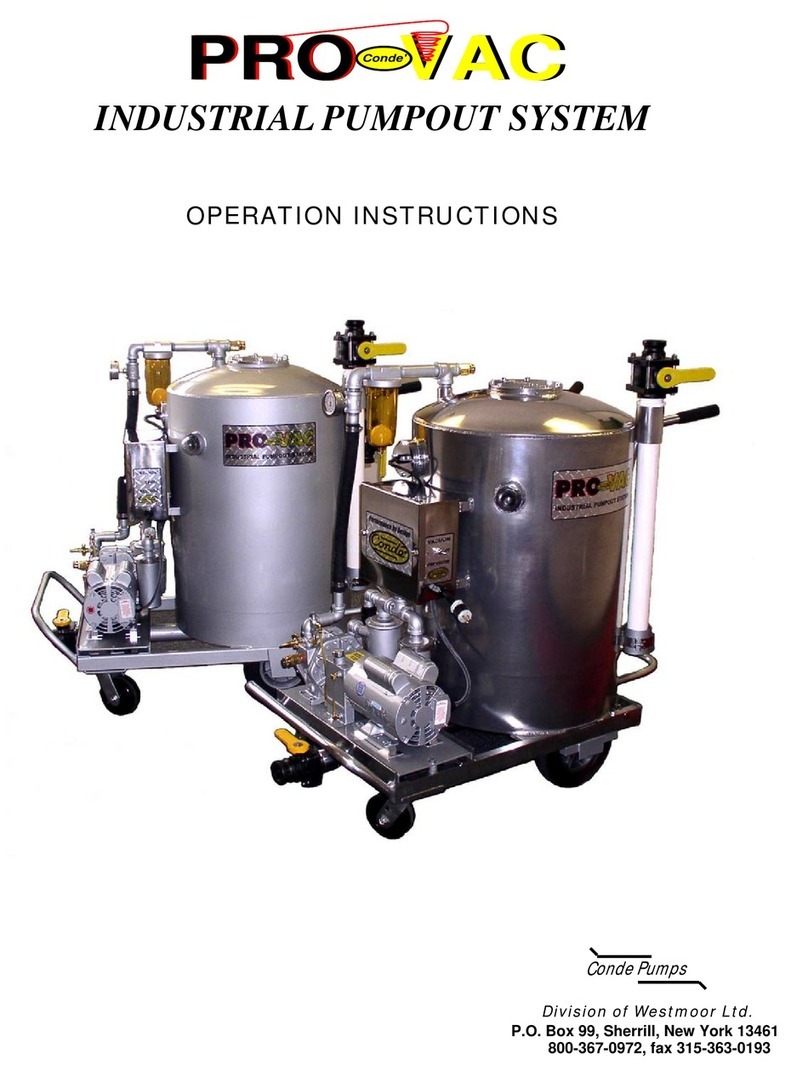
OIL RECOMMENDATIONS
Use high detergent 10W-30 motor oil only. Synthetic oil is highly recommended and will extend the
life of your pump. Using the proper type and weight oil is essential for long life and trouble free opera-
tion. Using the wrong oil or dirty oil can cause loss of vacuum or pump failure. Never run the
pump without oil in the tank oiler. Running the pump without oil in the reservoir
will cause pump failure!
Changing the oil is not necessary since the oil is discharged from the pump and should be properly dis-
posed of.
Check the oil level daily or every 8 hours of operation.
Any oil catch devises used with the pump unit should be periodically drained to avoid oil being blown out
the exhaust. This used oil should not be re-used.
GENERAL MAINTENANCE
If pump is pulley driven, adjust belt to 1/2” of free play at center of the pulleys. Make the first adjustment
after the first 24 hours of operation. Make any additional adjustments when necessary.
Generally, the only maintenance required on the ProVac 3 vacuum pump, is to maintain oil in the oil res-
ervoir. It is imperative that the pump is always getting the proper supply of oil. Periodically or at least
once a week, visually look at the window in the oil dripper, or the wick oiler oil tube, to make sure the
proper amount of oil is being drawn into the pump. If no oil is being sucked into the pump, immediately
turn the pump off. Please refer to the trouble shooting section of this manual for more information on
correcting the problem.
The pump should be isolated from any contaminates so that no foreign substance or moisture can enter
the pump. However, if anything is inadvertently sucked into the pump, the pump should be flushed im-
mediately to remove all contaminates. If it is not immediately flushed, rust can form inside the pump
which can, in turn, cause pump failure.
FLUSHING INSTRUCTIONS
It may be necessary to flush your pump to remove and gum or varnish buildup inside the pump that
causes the vanes to stick inside their slots. This is a simple maintenance operation and should be the
first step when troubleshooting a loss of vacuum in a system. Before starting, be sure the exhaust
from the oil catching devise (oil catch muffler) is directed away from the motor or engine and any
other hot surfaces). Open the flush valve on ProVac 3 model and insert a tube into it. On vacuum
only models, detach the oil tube from its connection to the oil tank. Use kerosene or diesel fuel for
flushing. NEVER USE GASOLINE OR OTHER HIGHLY FLAMMABLE LIQUID FOR FLUSHING.
While the pump is running under vacuum (slide valve in out position on HD models), simply insert the
other end of the tube into the cleaning fluid and allow the pump to draw the fluid in. If there is no vac-
uum present, disconnect the air hose from the top of the slide valve on HD models, or disconnect the
intake hose to the tank on vacuum only models, and pour a couple of ounces of cleaning fluid in. Alter-
nately, let air into the tube in the cleaning solution. It can take up to a quart of cleaning solution to flush
out a pump. When flushing is complete, draw about five ounces of oil into the pump in the same man-
ner. This completes the flushing process. Remove the tube from the flush valve and close it on the HD
models, or reattach the oil tube to the tank oiler on vacuum only models. Finally, reconnect any hoses
that were disconnected.
On badly gummed up pumps it may be necessary to pour a large quantity of cleaning fluid into the pump
(enough to fill the entire pump) and let it sit over night. Be careful to drain as much of the cleaning fluid
as possible out of the pump before attempting to turn the pump on.
Page 2




























